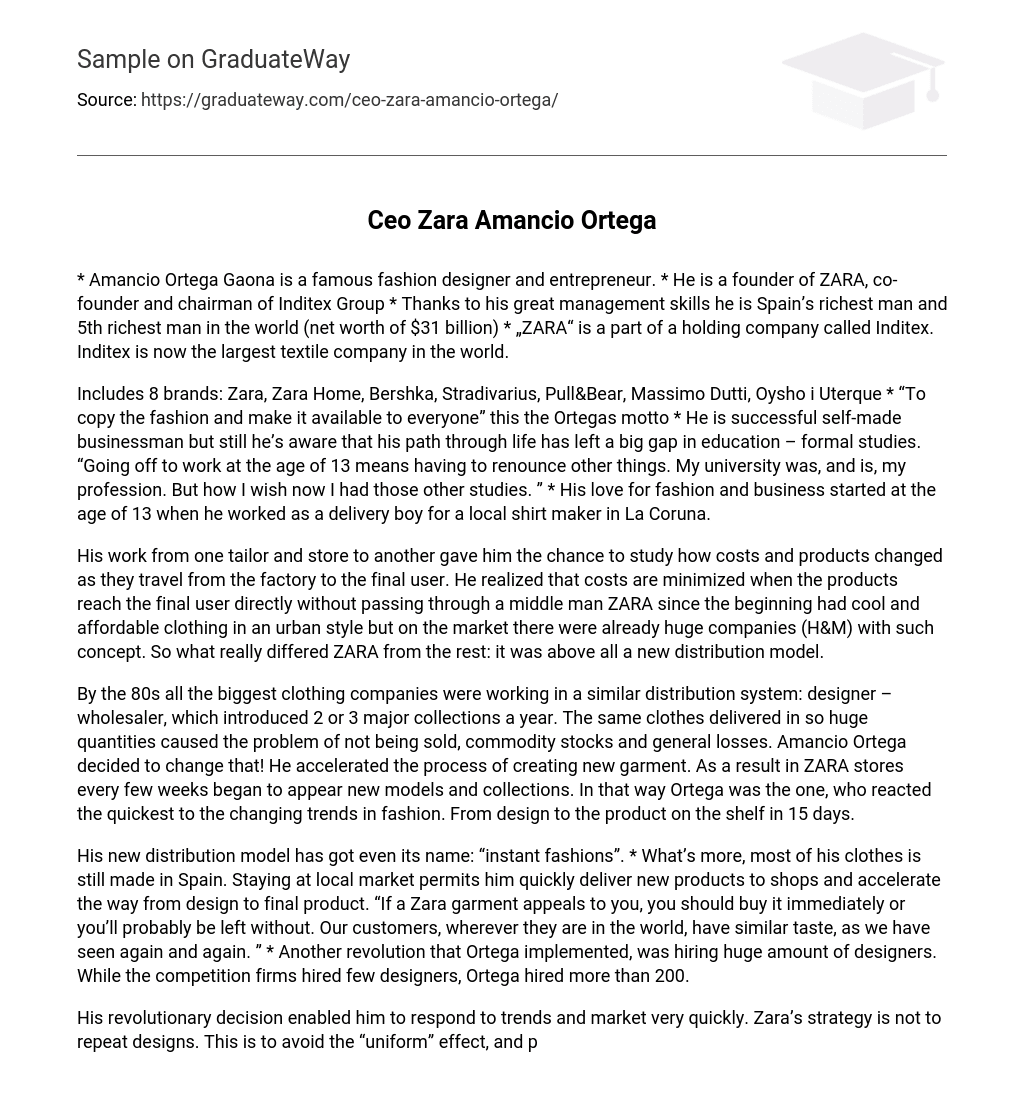Amancio Ortega Gaona is a famous fashion designer and entrepreneur. He is a founder of ZARA, co-founder and chairman of Inditex Group Thanks to his great management skills he is Spain’s richest man and 5th richest man in the world (net worth of $31 billion) „ZARA“ is a part of a holding company called Inditex. Inditex is now the largest textile company in the world.
Includes 8 brands: Zara, Zara Home, Bershka, Stradivarius, Pull&Bear, Massimo Dutti, Oysho i Uterque. “To copy the fashion and make it available to everyone” this the Ortegas motto. He is successful self-made businessman but still he’s aware that his path through life has left a big gap in education – formal studies. “Going off to work at the age of 13 means having to renounce other things. My university was, and is, my profession. But how I wish now I had those other studies. ” His love for fashion and business started at the age of 13 when he worked as a delivery boy for a local shirt maker in La Coruna.
His work from one tailor and store to another gave him the chance to study how costs and products changed as they travel from the factory to the final user. He realized that costs are minimized when the products reach the final user directly without passing through a middle man ZARA since the beginning had cool and affordable clothing in an urban style but on the market there were already huge companies (H&M) with such concept. So what really differed ZARA from the rest: it was above all a new distribution model.
By the 80s all the biggest clothing companies were working in a similar distribution system: designer – wholesaler, which introduced 2 or 3 major collections a year. The same clothes delivered in so huge quantities caused the problem of not being sold, commodity stocks and general losses. Amancio Ortega decided to change that! He accelerated the process of creating new garment. As a result in ZARA stores every few weeks began to appear new models and collections. In that way Ortega was the one, who reacted the quickest to the changing trends in fashion. From design to the product on the shelf in 15 days.
His new distribution model has got even its name: “instant fashions”. What’s more, most of his clothes is still made in Spain. Staying at local market permits him quickly deliver new products to shops and accelerate the way from design to final product. “If a Zara garment appeals to you, you should buy it immediately or you’ll probably be left without. Our customers, wherever they are in the world, have similar taste, as we have seen again and again. ”
Another revolution that Ortega implemented, was hiring huge amount of designers. While the competition firms hired few designers, Ortega hired more than 200. His revolutionary decision enabled him to respond to trends and market very quickly. Zara’s strategy is not to repeat designs. This is to avoid the “uniform” effect, and partly explains the rapid turnover of styles.
Ortega doesn’t perform any representative roles. He also does not seem to perform any duties of ceremonial nature. He has a reputation as a private and secretive man. One of his core principles is never to be in the centre of attention; he is seldom either photographed or interviewed. (remaining unphotographed until the year 2000, when he was snapped having breakfast in the suburb of Matogrande (La Coruna).
Until then, there had even been suspicions that he might not exist). Ortega was also known for being a down-to-earth boss. Despite being owner of one of biggest fashion brand he likes to dress casually He never wore a tie to work and had lunches with his employees in the canteen.
Work, and work with passion. This is what my parents, ordinary working class people who lived through the precarious post-Spanish Civil War years, always told me. And I’ve never been happier than when being just one more face in the crowd. ” Money has never shifted his focus and he continued to work hard. He is a workaholic and likes to do his work himself and doesn’t take vacations. “Zara, for me, is serenity, not spectacle,” Ortega has said. “It is a brand born of the desire to see women, all over the world, well dressed but without extravagance. It’s true you have to select a particular style, as you can’t take into account the style characteristics of every part of the globe. You don’t design differently for 80 countries,” he says, “but design one style for 80 countries. It’s not that complicated. ”
Being true to one’s essentials is of vital importance to Ortega: “As I’ve often said to my wife Flori, who was herself dedicated for many years to clothes design, I do not want our stores to be full of luxury items, things that have nothing to do with who we are, essentially, as human beings. Our strength is appealing to a real public, to real women. We don’t sell dreams. ”





